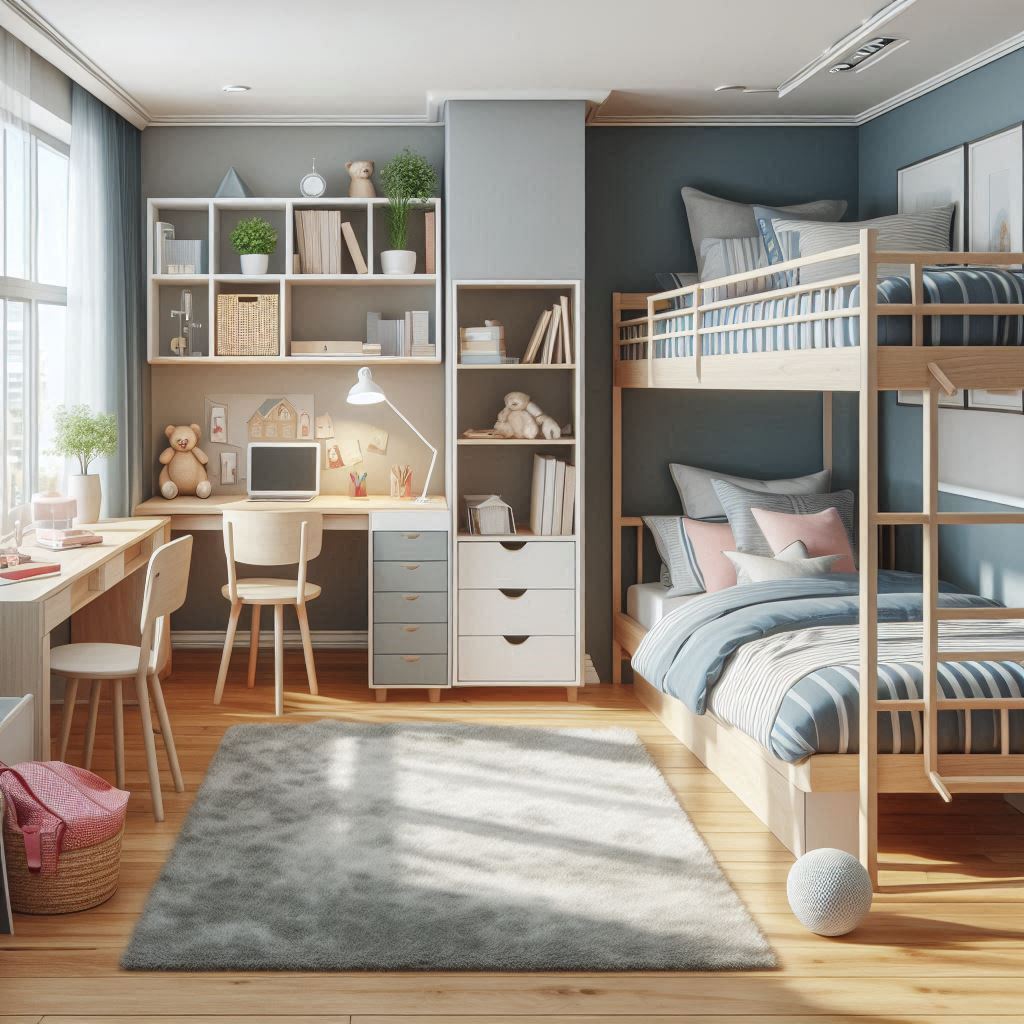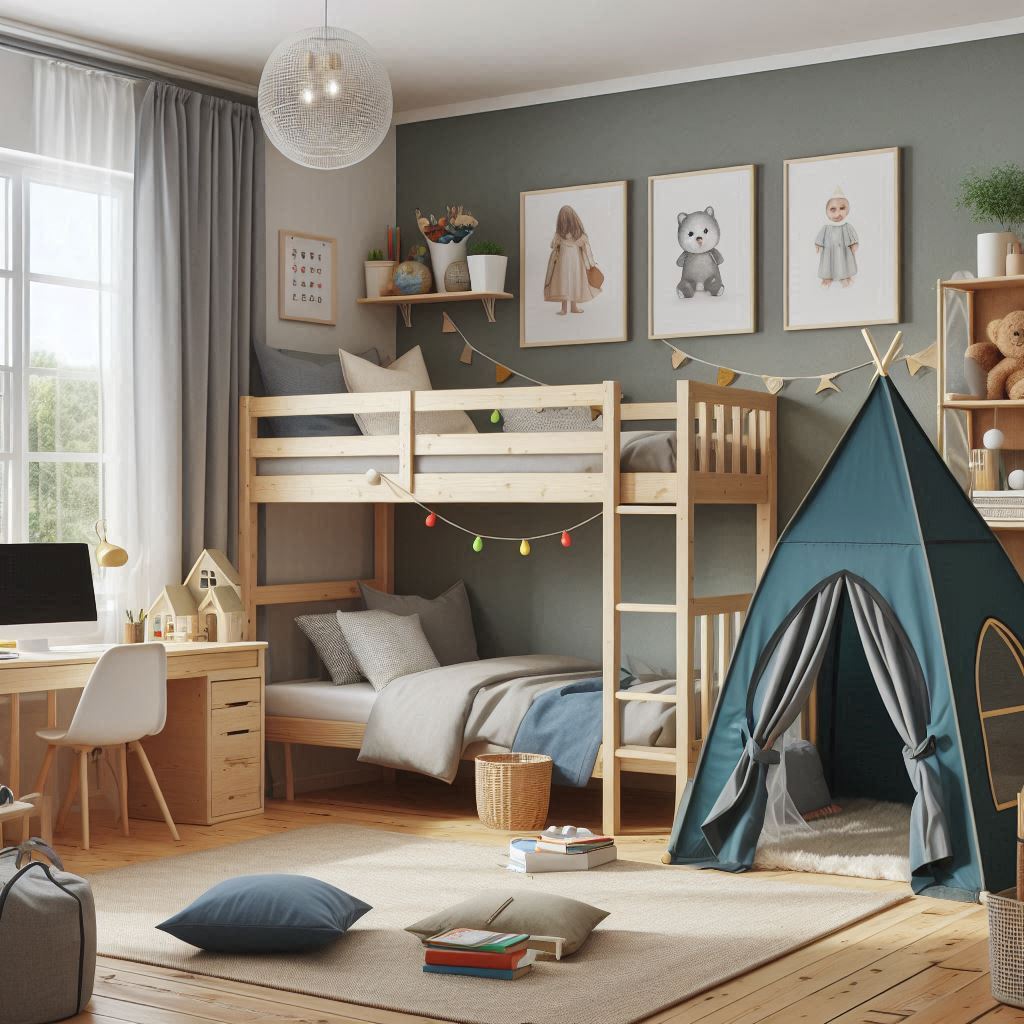
Designing a kids’ bedroom is all about creating a space that’s functional, comfortable, and tailored to their needs. Whether you’re planning a room for one child or making the space work for siblings, these tips will help you create a space where children can rest, play, and grow:-
1. Choose a Flexible Layout: A room layout that can adapt as children grow is key, especially when more than one child shares the space. Consider bunk beds or trundle beds to save floor space, or opt for furniture that can be rearranged easily. Creating designated areas for sleep, study, and play can make the room work better for multiple kids.
2. Use Neutral Base Colours with Bold Accents: A neutral base colour—like white, cream, or light grey—provides a calm backdrop and can grow with your children. Add vibrant touches with accessories like cushions, bedding, or wall art, allowing each child to express their personality through pops of colour. For shared rooms, use a blend of colours that each child likes.
3. Smart Storage Solutions: Maximise storage with under-bed drawers, built-in wardrobes, and toy boxes. Wall shelves and cubby storage can help keep toys, books, and school supplies organised. Labelling bins or baskets can encourage kids to tidy up. In a shared space, consider giving each child their own storage areas to help maintain a sense of personal space.
4. Create a Cosy Reading Nook: A reading nook can encourage a love for books and provide a quiet retreat. A bean bag, cosy chair, or a stack of cushions near a bookshelf is all you need. This space can also double as a calm corner for unwinding after a busy day.
5. Make It Personal: Let each child contribute to the design by choosing their bedding, wall art, or decorations. This will help them feel more at home in their space. For siblings, creating small zones or using decorative room dividers can give them a sense of individuality within the same room.
6. Prioritise Quality Sleep: Good-quality bedding, blackout curtains, and the right mattress can make all the difference for restful sleep. Consider a nightlight for younger children and ensure that the sleeping area is free from distractions like screens or toys.
7. Functional Study Areas: If the room is for school-age children, set up a study space with a desk and proper lighting. For shared bedrooms, consider separate desks if space allows, or use a longer desk that can accommodate both children. A clutter-free study area will help them focus better on their homework.
8. Keep Safety in Mind: From securing furniture to the walls to using non-slip rugs, safety is a top priority. For younger children, ensure any heavy items are out of reach and that toys are age-appropriate. Bunk beds should have sturdy ladders and safety rails to prevent falls.
9. Make the Most of Vertical Space: For smaller rooms, vertical storage can be a lifesaver. Use tall bookcases or install shelves high up on the walls to store items that aren’t used every day. Wall hooks can be great for hanging backpacks, coats, or dressing gowns.
10. Plan for Play: Leave space for play and imagination! A soft rug can create a play area, or consider using a teepee or play tent for a bit of adventure. If space is tight, foldable play mats or stackable toys can offer flexibility.

Designing a kids’ bedroom that balances function, fun, and a bit of personal flair is a rewarding challenge. With thoughtful planning, you can create a space that feels like a sanctuary, perfect for sleep, study, and play.
If you’re feeling overwhelmed by the thought of tackling these updates yourself, don’t worry, help is just a few clicks away. You can post a job on www.Tradesmen.ie and get help from a range of skilled professionals, including interior designers, carpenters, handymen, electricians, and many other tradespeople. They can help you turn your kids’ bedroom into a beautiful and functional space that your children will love and enjoy for years to come:-)
Cheers
Oliver Dempsey
Tradesmen.ie
21 October 2024
General Tips for hiring a tradesman
Here are some tips to consider when hiring a tradesman:-
1. Ask for phone numbers of references so that you can check them out
2. Check insurance of the tradesman where insurance is required
3. Hire a suitably qualified architect, building surveyor or building engineer if the job is anything to do with a new build, building renovation or extension






